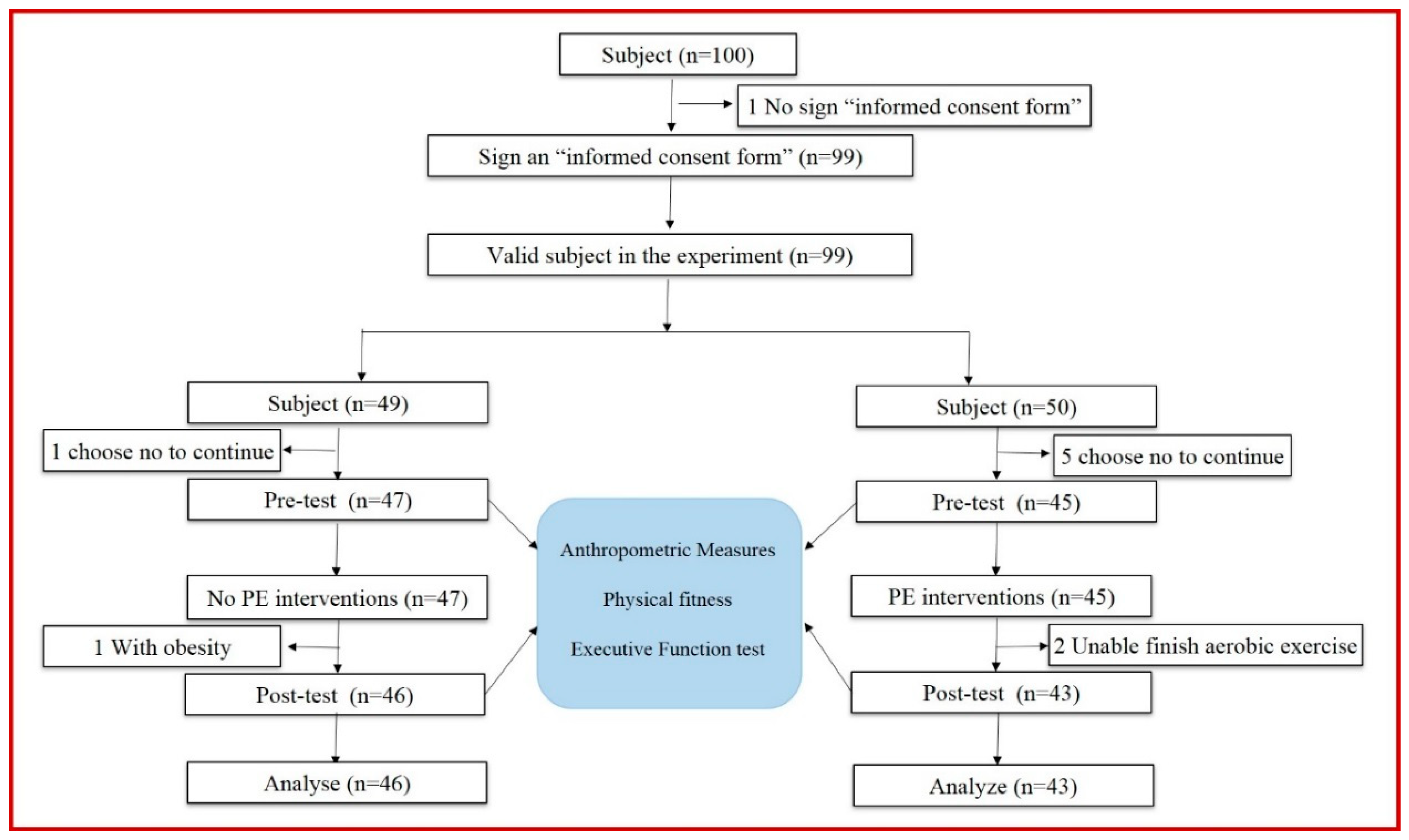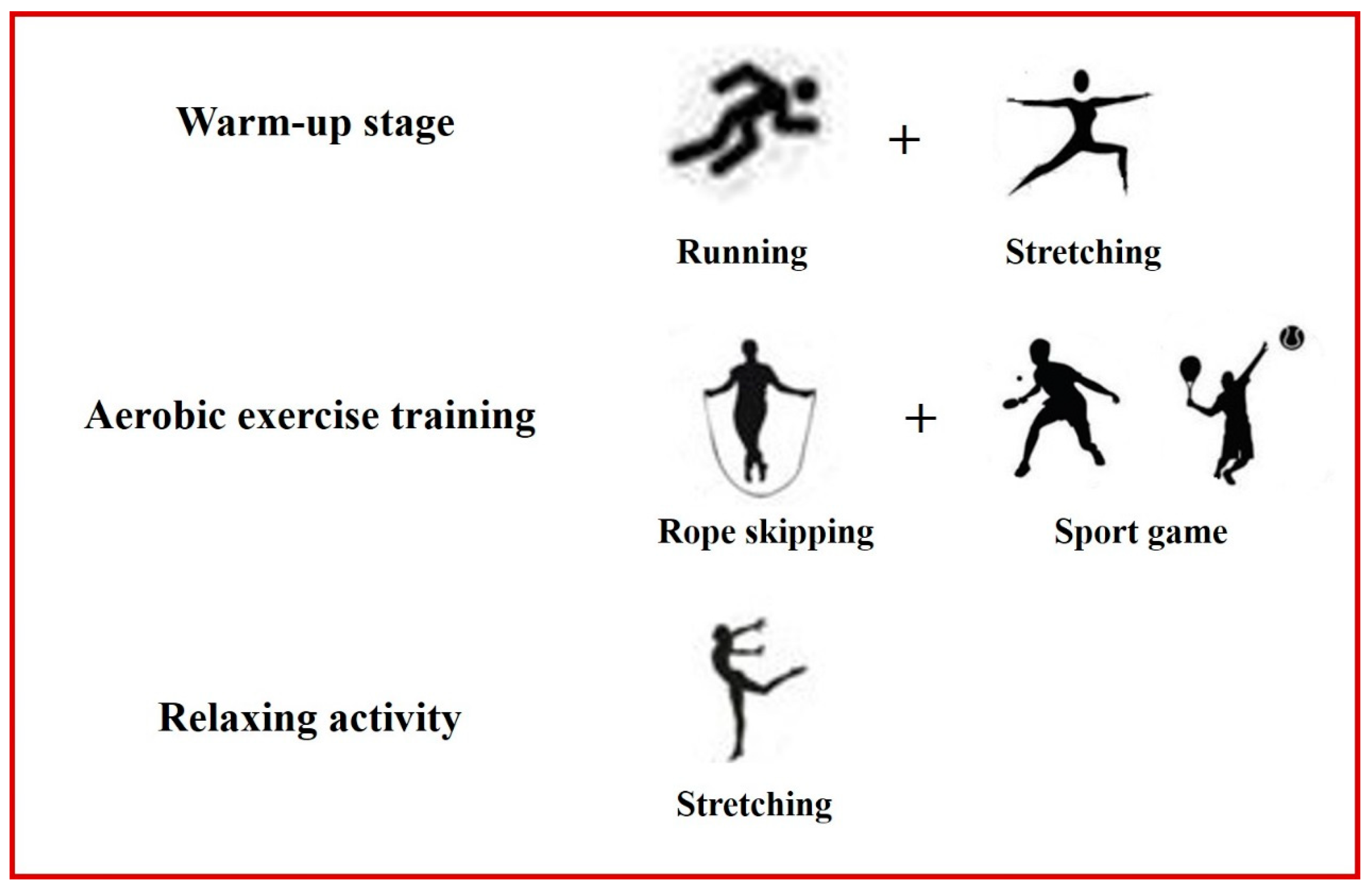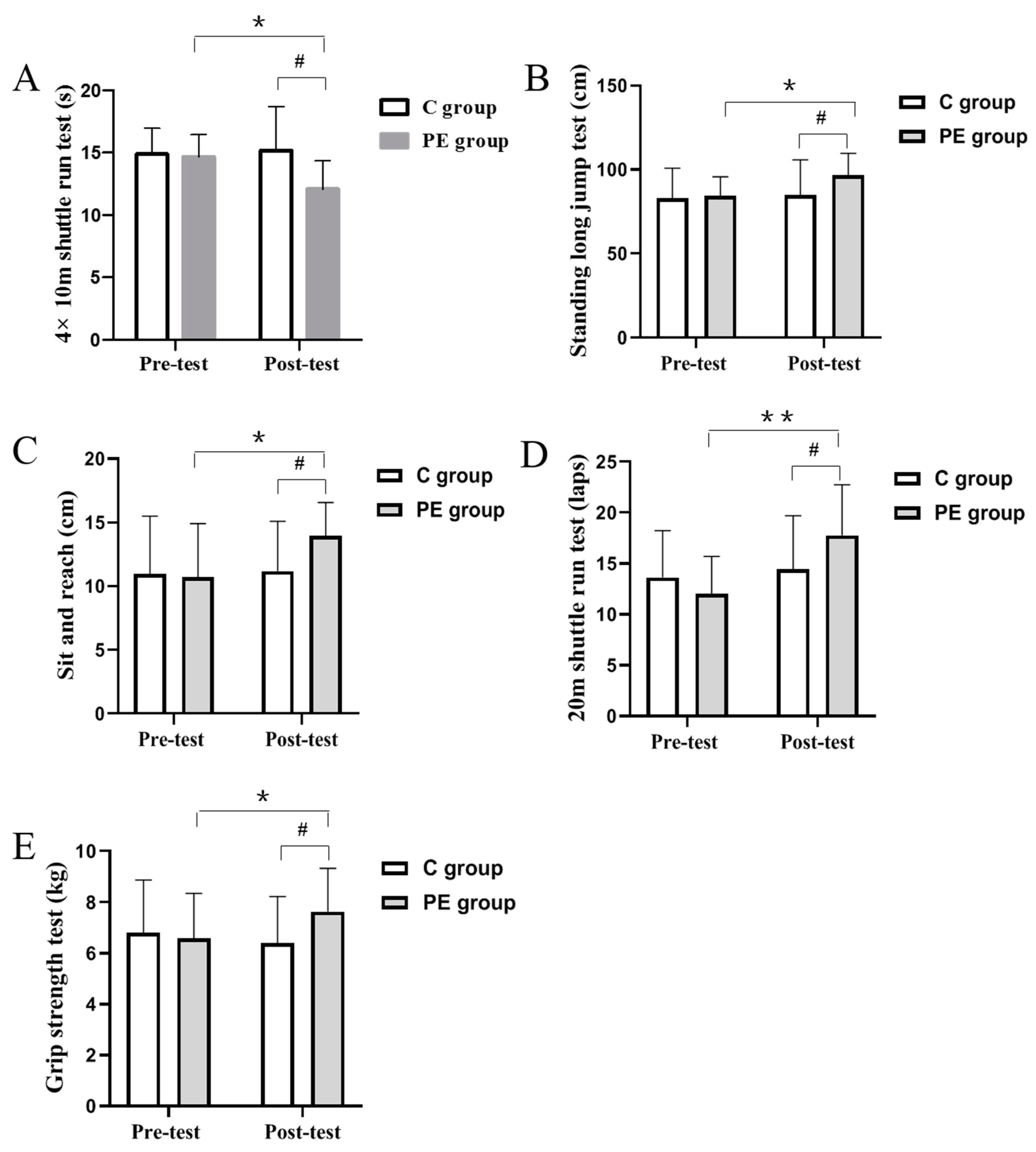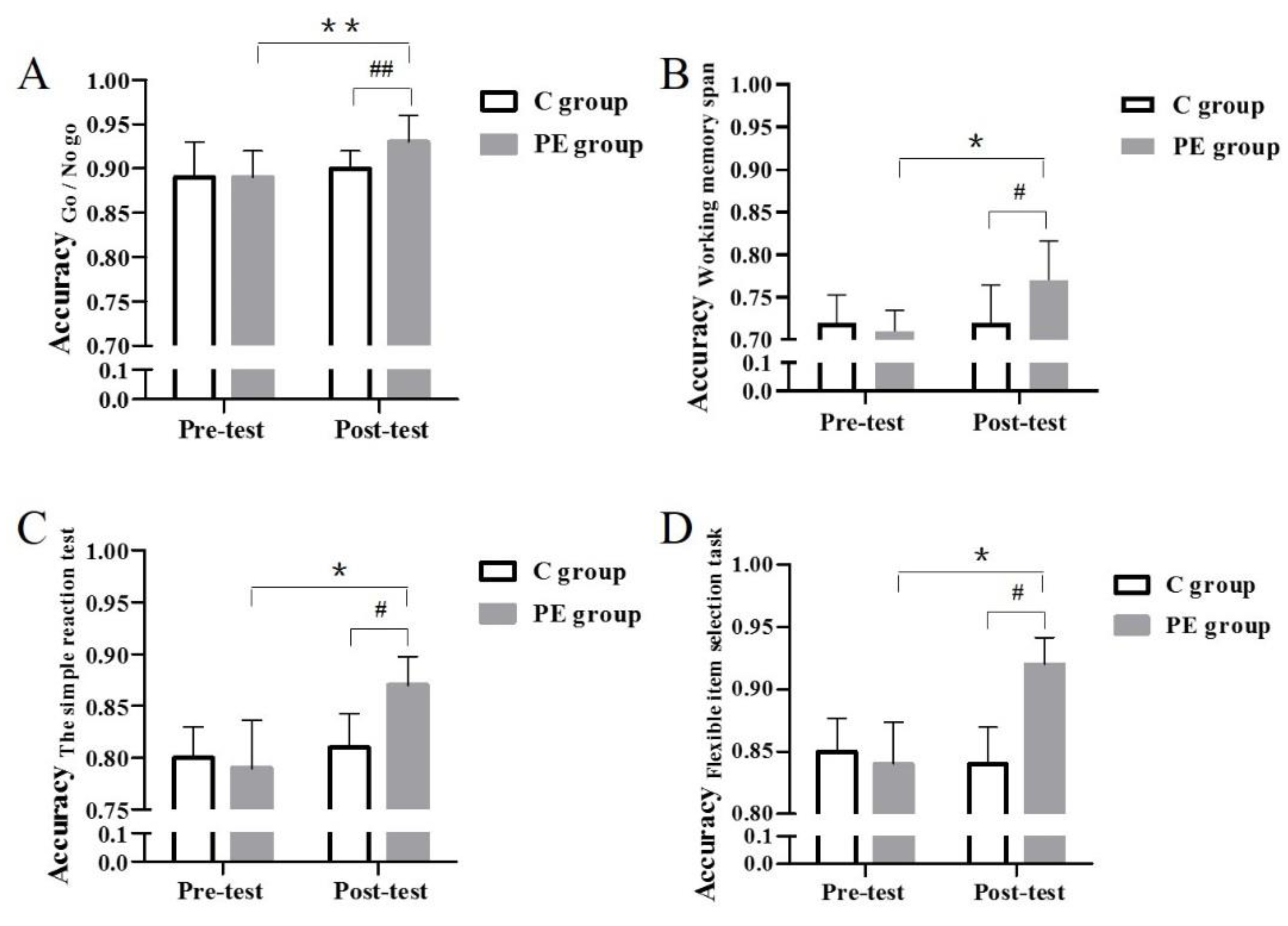Effect of 11 Weeks of Physical Exercise on Physical Fitness and Executive Functions in Children
Abstract
1. Introduction
2. Materials and Methods
2.1. Participants
2.2. Physical Exercise Interventions
2.3. Body Composition and Sedentary Behavior
2.4. PF Test
2.5. EFs Test
2.6. Statistical Analysis
3. Results
3.1. Basic Information of Children
3.2. Effect of 11 Weeks of Physical Exercise on PF in Children
3.3. Effect of 11 Weeks of Physical Exercise on EFs on Children
4. Discussion
5. Conclusions
Author Contributions
Funding
Institutional Review Board Statement
Informed Consent Statement
Data Availability Statement
Acknowledgments
Conflicts of Interest
References
- Hohmann, A.; Yuan, X.; Schmitt, M.; Zhang, H.; Pietzonka, M.; Siener, M. Physical Fitness and Motor Competence in Chinese and German Elementary School Children in Relation to Different Physical Activity Settings. Children 2021, 8, 391. [Google Scholar] [CrossRef] [PubMed]
- Huang, W.; Luo, J.; Chen, Y. Effects of Kindergarten, Family Environment, and Physical Activity on Children’s Physical Fitness. Front. Public Health 2022, 10, 904903. [Google Scholar] [CrossRef] [PubMed]
- Yip, K.M.; Wong, S.W.S.; Chua, G.T.; So, H.-K.; Ho, F.K.; Wong, R.S.; Tung, K.T.S.; Chan, E.Y.N.; Tso, W.W.Y.; Chow, B.-C.; et al. Age-and Sex-Specific Physical Fitness Reference and Association with Body Mass Index in Hong Kong Chinese Schoolchildren. Int. J. Environ. Res. Public Health 2022, 19, 15346. [Google Scholar] [CrossRef] [PubMed]
- Li, Y.; Xia, X.; Meng, F.; Zhang, C. Association between physical fitness and anxiety in children: A moderated mediation model of agility and resilience. Front. Public Health 2020, 8, 468. [Google Scholar] [CrossRef] [PubMed]
- Kuiper, K.C.; Swaab, H.; Tartaglia, N.; van Buggenhout, G.; Wouters, C.; van Rijn, S. The developmental impact of sex chromosome trisomies on emerging executive functions in young children: Evidence from neurocognitive tests and daily life skills. Genes Brain Behav. 2022, 21, e12811. [Google Scholar] [CrossRef]
- Kim, S.Y.; Song, J.; Wen, W.; Chen, S.; Zhang, M.; Yan, J.; Lopez, B.G.; Arredondo, M.M.; Ip, K.I. Culturally relevant stressors as moderators of intergenerational transmission of mother-adolescent executive function in Mexican immigrant families. Cogn. Res. Princ. Implic. 2021, 6, 70. [Google Scholar] [CrossRef]
- Ronan, L.; Alexander-Bloch, A.; Fletcher, P.C. Childhood Obesity, Cortical Structure, and Executive Function in Healthy Children. Cereb. Cortex. 2020, 30, 2519–2528. [Google Scholar] [CrossRef]
- Papastergiou, A.; Pappas, V.; Sanoudaki, E. The executive function of bilingual and monolingual children: A technical efficiency approach. Behav. Res. Methods 2022, 54, 1319–1345. [Google Scholar] [CrossRef]
- Feola, B.; Dougherty, L.R.; Riggins, T.; Bolger, D.J. Prefrontal cortical thickness mediates the association between cortisol reactivity and executive function in childhood. Neuropsychologia 2020, 148, 107636. [Google Scholar] [CrossRef]
- Pop, T.L.; Maniu, D.; Rajka, D.; Lazea, C.; Cismaru, G.; Ştef, A.; Căinap, S.S. Prevalence of underweight, overweight and obesity in school-aged children in the urban area of the northwestern part of Romania. Int. J. Environ. Res. Public Health 2021, 18, 5176. [Google Scholar] [CrossRef]
- Neil-Sztramko, S.E.; Caldwell, H.; Dobbins, M. School-based physical activity programs for promoting physical activity and fitness in children and adolescents aged 6 to 18. Cochrane Database Syst. Rev. 2021, 2021, CD007651. [Google Scholar]
- Wang, H.; Ge, W.; Zhu, C.; Sun, Y.; Wei, S. How pom cheerleading improves the executive function of preschool children: The mediating role of speed and agility. BMC Psychol. 2022, 10, 234. [Google Scholar] [CrossRef] [PubMed]
- Carson, V.; Lee, E.Y.; Hewitt, L.; Jennings, C.; Hunter, S.; Kuzik, N.; Stearns, J.A.; Unrau, S.P.; Poitras, V.J.; Gray, C.; et al. Systematic review of the relationships between physical activity and health indicators in the early years (0–4 years). BMC Public Health 2017, 17, 33–63. [Google Scholar]
- De Greeff, J.W.; Bosker, R.J.; Oosterlaan, J.; Visscher, C.; Hartman, E. Effects of physical activity on executive functions, attention and academic performance in preadolescent children: A meta-analysis. J. Sci. Med. Sport 2018, 21, 501–507. [Google Scholar] [CrossRef] [PubMed]
- Verburgh, L.; Königs, M.; Scherder, E.J.A.; Oosterlaan, J. Physical exercise and executive functions in preadolescent children, adolescents and young adults: A meta-analysis. Br. J. Sport Med. 2014, 48, 973–979. [Google Scholar] [CrossRef]
- Mehren, A.; Diaz Luque, C.; Brandes, M.; Lam, A.P.; Thiel, C.M.; Philipsen, A.; Özyurt, J. Intensity-dependent effects of acute exercise on executive function. Neural Plast. 2019, 2019, 8608317. [Google Scholar] [CrossRef] [PubMed]
- Diamond, A. Close interrelation of motor development and cognitive development and of the cerebellum and prefrontal cortex. Child Dev. 2000, 71, 44–56. [Google Scholar] [CrossRef]
- Ji, C.; Yang, J.; Lin, L.; Chen, S. Executive Function Improvement for Children with Autism Spectrum Disorder: A Comparative Study between Virtual Training and Physical Exercise Methods. Children 2022, 9, 507. [Google Scholar] [CrossRef]
- Xiong, X.; Zhu, L.N.; Dong, X.X.; Wang, W.; Yan, J.; Chen, A.G. Aerobic Exercise Intervention Alters Executive Function and White Matter Integrity in Deaf Children: A Randomized Controlled Study. Neural Plast. 2018, 2018, 3735208. [Google Scholar] [CrossRef] [PubMed]
- Chen, A.; Zhu, L.; Jin, L.; Xiong, X.; Wang, W.; Yan, J. Effects of Aerobic Exercise on Executive Control and Its Brain Network in Deaf Children. Sport. Sci. 2016, 37, 94–101. [Google Scholar]
- Martinez-Tellez, B.; Sanchez-Delgado, G.; Cadenas-Sanchez, C.; Mora-Gonzalez, J.; Martín-Matillas, M.; Löf, M.; Ortega, F.B.; Ruiz, J.R. Health-related physical fitness is associated with total and central body fat in preschool children aged 3 to 5 years. Pediatr. Obes. 2016, 11, 468–474. [Google Scholar] [CrossRef]
- Houwen, S.; Visscher, C.; Hartman, E.; Lemmink, K.A. Test-Retest Reliability of Eurofit Physical Fitness Items for Children with Visual Impairments. Pediatr. Exerc. Sci. 2006, 18, 300–313. [Google Scholar] [CrossRef]
- Durston, S.; Thomas, K.M.; Yang, Y.; Uluğ, A.M.; Zimmerman, R.D.; Casey, B.J. A neural basis for the development of inhibitory control. Dev. Sci. 2002, 5, F9–F16. [Google Scholar] [CrossRef]
- Kane, M.J.; Engle, R.W. Working-memory capacity and the control of attention: The contributions of goal neglect, response competition, and task set to Stroop interference. J. Exp. Psychol. Gen. 2003, 132, 47–70. [Google Scholar] [CrossRef]
- Wang, Y.; Zhu, H.; Chen, C.; Meng, W.; Rong, X.; Liu, K. The Relationship between Body Balance and Cognition of College Students in Different Majors. In Proceedings of the 2014 Asia-Pacific Congress on Sports Technology and Engineering (STE 2014), Singapore, 8–9 December 2014; pp. 131–135. [Google Scholar]
- Jacques, S.; Zelazo, P.D. The Flexible Item Selection Task (FIST): A measure of executive function in preschoolers. Dev. Neuropsychol. 2001, 20, 573–591. [Google Scholar] [CrossRef]
- Badiane, A.; Diouf, A.; Sylla, P.M.D.D.; Cissé, N.S.; Idohou-Dossou, N.; Dramaix, M.; Wade, S.; Donnen, P. Body composition and determinant factors among mother-child pairs (6–8 months) in rural areas of Senegal. Matern. Child Nutr. 2021, 17, e13174. [Google Scholar] [CrossRef] [PubMed]
- Wang, L.; Shi, C.; Zhao, Z. The research and development of growth curve for children’s height and weight on Android platform. In Proceedings of the 2017 10th International Congress on Image and Signal Processing, Shanghai, China, 14–16 October 2017. [Google Scholar]
- Alberty, R.; Čillík, I. Effect of after-school physical activity on body composition in primary school children: The Slovak “PAD” project. Physiol. Rep. 2023, 11, e15540. [Google Scholar] [CrossRef] [PubMed]
- Wang, G.; Zi, Y.; Li, B.; Su, S.; Sun, L.; Wang, F.; Ren, C.; Liu, Y. The Effect of Physical Exercise on Fundamental Movement Skills and Physical Fitness among Preschool Children: Study Protocol for a Cluster-Randomized Controlled Trial. Int. J. Environ. Res. Public Health 2022, 19, 6331. [Google Scholar] [CrossRef] [PubMed]
- Park, S.K.; Lee, K.S.; Heo, S.J.; Jee, Y.S. Effects of High Intensity Plank Exercise on Physical Fitness and Immunocyte Function in a Middle-Aged Man: A Case Report. Medicina 2021, 57, 845. [Google Scholar] [CrossRef]
- Lee, C.K.; Sim, Y.K.; Lee, J.-H.; Yook, J.S.; Ha, S.-M.; Seo, E.C.; So, W.-Y.; Kim, H.-R.; Jeong, W.-M.; Goo, B.O.; et al. The Relationship between Body Composition and Physical Fitness and the Effect of Exercise According to the Level of Childhood Obesity Using the MGPA Model. Int. J. Environ. Res. Public Health 2022, 19, 487. [Google Scholar] [CrossRef]
- Ortega, F.B.; Mora-Gonzalez, J.; Cadenas-Sanchez, C.; Esteban-Cornejo, I.; Migueles, J.H.; Solis-Urra, P.; Verdejo-Román, J.; Rodriguez-Ayllon, M.; Molina-Garcia, P.; Ruiz, J.R.; et al. Effects of an Exercise Program on Brain Health Outcomes for Children With Overweight or Obesity: The ActiveBrains Randomized Clinical Trial. JAMA Netw. Open 2022, 5, e2227893. [Google Scholar] [CrossRef] [PubMed]
- Xue, Y.; Yang, Y.; Huang, T. Effects of chronic exercise interventions on executive function among children and adolescents: A systematic review with meta-analysis. Brit. J. Sport Med. 2019, 53, 1397–1404. [Google Scholar] [CrossRef] [PubMed]
- Liu, S.; Yu, Q.; Li, Z.; Cunha, P.M.; Zhang, Y.; Kong, Z.; Lin, W.; Chen, S.; Cai, Y. Effects of acute and chronic exercises on executive function in children and adolescents: A systemic review and meta-analysis. Front. Psychol. 2020, 11, 3482. [Google Scholar] [CrossRef] [PubMed]
- Bliss, E.S.; Wong, R.H.; Howe, P.R.; Mills, D.E. Benefits of exercise training on cerebrovascular and cognitive function in ageing. J. Cereb. Blood Flow Metab. 2021, 41, 447–470. [Google Scholar] [CrossRef] [PubMed]
- Stillman, C.M.; Esteban-Cornejo, I.; Brown, B.; Bender, C.M.; Erickson, K.I. Effects of Exercise on Brain and Cognition Across Age Groups and Health States. Trends Neurosci. 2020, 43, 533–543. [Google Scholar] [CrossRef] [PubMed]
- Sanders, L.M.J.; Hortobágyi, T.; Karssemeijer, E.G.A.; Van der Zee, E.A.; Scherder, E.J.A.; van Heuvelen, M.J.G. Effects of low- and high-intensity physical exercise on physical and cognitive function in older persons with dementia: A randomized controlled trial. Alzheimers Res. Ther. 2020, 12, 28. [Google Scholar] [CrossRef] [PubMed]
- Srinivas, N.S.; Vimalan, V.; Padmanabhan, P.; Gulyas, B. An overview on cognitive function enhancement through physical exercises. Brain Sci. 2021, 11, 1289. [Google Scholar] [CrossRef]
- Li, L.; Zhang, S.; Cui, J.; Chen, L.Z.; Wang, X.; Fan, M.; Wei, G.X. Fitness-Dependent Effect of Acute Aerobic Exercise on Executive Function. Front. Physiol. 2019, 10, 902. [Google Scholar] [CrossRef]




| Pre-Test | Post-Test | |||
|---|---|---|---|---|
| C Group | PE Group | C Group | PE Group | |
| Height [cm] | 125.71 ± 2.09 | 125.29 ± 2.74 | 128.09 ± 2.76 | 127.47 ± 3.00 |
| Weight [kg] | 17.77 ± 2.70 | 18.91 ± 3.41 | 21.16 ± 3.44 | 22.20 ± 2.36 |
| BMI [kg/m2] | 17.21 ± 2.7 | 16.20 ± 1.77 | 17.11 ± 3.30 | 16.19 ± 2.21 |
Disclaimer/Publisher’s Note: The statements, opinions and data contained in all publications are solely those of the individual author(s) and contributor(s) and not of MDPI and/or the editor(s). MDPI and/or the editor(s) disclaim responsibility for any injury to people or property resulting from any ideas, methods, instructions or products referred to in the content. |
© 2023 by the authors. Licensee MDPI, Basel, Switzerland. This article is an open access article distributed under the terms and conditions of the Creative Commons Attribution (CC BY) license (https://creativecommons.org/licenses/by/4.0/).
Share and Cite
Zhang, M.; Garnier, H.; Qian, G.; Li, S. Effect of 11 Weeks of Physical Exercise on Physical Fitness and Executive Functions in Children. Children 2023, 10, 485. https://doi.org/10.3390/children10030485
Zhang M, Garnier H, Qian G, Li S. Effect of 11 Weeks of Physical Exercise on Physical Fitness and Executive Functions in Children. Children. 2023; 10(3):485. https://doi.org/10.3390/children10030485
Chicago/Turabian StyleZhang, Mingyang, Hanna Garnier, Guoping Qian, and Shunchang Li. 2023. "Effect of 11 Weeks of Physical Exercise on Physical Fitness and Executive Functions in Children" Children 10, no. 3: 485. https://doi.org/10.3390/children10030485
APA StyleZhang, M., Garnier, H., Qian, G., & Li, S. (2023). Effect of 11 Weeks of Physical Exercise on Physical Fitness and Executive Functions in Children. Children, 10(3), 485. https://doi.org/10.3390/children10030485





